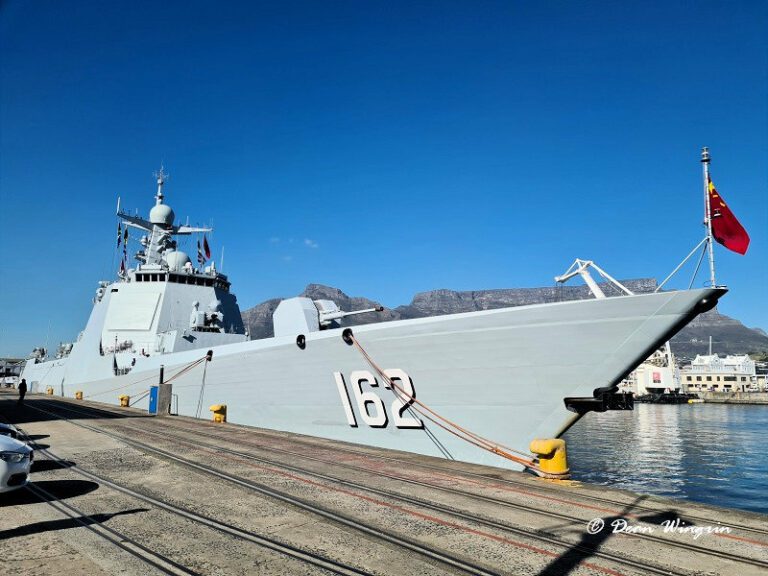The 43rd Chinese naval escort taskforce, a division of the People’s Liberation Army Navy (PLAN), made its arrival in Cape Town on the morning of July 24th, commencing a three-day goodwill visit. This visit is part of a broader diplomatic initiative, following the completion of its escort mission in the Gulf of Aden and the waters off Somalia.
The taskforce then embarked on a journey along the West coast of Africa, making several diplomatic stops in countries including the Ivory Coast, Ghana, Nigeria, Gabon, and the Democratic Republic of the Congo. These visits underscore China’s commitment to fostering relationships with these nations.
The Chinese flotila’s July 3 five-days visit to Nigeria earlier was hailed by the Chinese Ambassador to Nigeria Mr Chi Chun as a milestone in the bilateral relationship between the two countries.
China has been actively seeking to expand its presence in Africa, particularly in terms of trade, investment, and infrastructure development. The visit of the Chinese naval fleet to Africa demonstrates Beijing’s commitment to deepening its engagement with African countries, even extending its military cooperation. Nevertheless, the US is determined to stop China’s naval expansion drive.
The 43rd Chinese taskforce is a formidable fleet, comprising the guided-missile destroyer Nanning (162), the guided-missile frigate Sanya (54), and the supply ship Weishanhu (887). The taskforce set sail from a military port in Zhanjiang city, located in southeast China’s Guangdong province, on January 10th. The fleet was accompanied by two ship-borne helicopters and a crew of over 700 sailors. This mission marked the first escort assignment for the destroyer Nanning.
During the mission, Nanning briefly detached from the taskforce to participate in multinational naval drills off Karachi, Pakistan. In March, the destroyer joined Iranian and Russian warships for a joint naval exercise in the Gulf of Oman, demonstrating China’s commitment to international military cooperation.
In a significant humanitarian effort in April, the destroyer Nanning and supply ship Weishanhu were dispatched to Port Sudan to aid in the evacuation of 678 individuals, primarily Chinese nationals, amidst the outbreak of civil war in Sudan.
The recent visit to Cape Town is not the first for a Chinese naval escort taskforce. Previous visits occurred in 2014, 2016, 2017, and 2018, all aimed at strengthening bilateral relations between China and South Africa. In 2019, warships from Russia and China arrived in Cape Town for the inaugural Exercise Mosi. Following a hiatus due to the Covid-19 pandemic, three Chinese naval ships from the 42nd naval escort task force participated in the second iteration of Exercise Mosi off the KwaZulu-Natal coast earlier this year.
The Chinese naval taskforce was warmly received by Vice Admiral Monde Lobese, Chief of the South African Navy, and Rear Admiral Bubele Mhlana, Chief of Staff at the Joint Operations Division. The local Chinese community also celebrated the arrival, displaying Chinese flags and performing a traditional Chinese dragon dance.
While the Chinese taskforce will not engage in joint sea exercises with the South African Navy during this visit, both parties will participate in discussions on cooperation in traditional and non-traditional security fields, as well as social matters. This visit further emphasizes the ongoing commitment to strengthening ties and fostering cooperation between China and South Africa.
The Chinese Navy Escort Task Group (ETG) 162, comprising the PLA destroyer Nanning, PLA frigate Sanya, and supply ship Weishanhu, arrived in South Africa to enhance the cooperation and strengthen the ties between the two nations.
Nanning (162) is a 7,500 ton Type 052DL destroyer of the People’s Liberation Army Navy, the ship was launched on 23 February 2019 at the Jiangnan Shipyard in Shanghai, and commissioned on 12 April 2021.
Armament consists of a 130 mm gun, a HQ-10 short-range SAM 24-cell launcher, 64-cell Vertical Launch System (VLS) and an array of surface-to-surface, surface-to-air and anti-submarine warfare missiles. A Harbin Z-20 helicopter is carried aboard.
The older 4 053 tonnes Type 054A frigate Sanya was commissioned on 30 November 2012. Her main gun is a 76 mm dual-purpose weapon supported by two 7-barrel 30 mm CIWS guns for close-in threats. She carries two torpedo launchers and two anti-submarine rocket launchers. The missile capability consists of HQ-16 medium-range air defence missiles and anti-submarine missiles in a vertical launch system. The frigate should be carrying either a Harbin Z-9C or Kamov Ka-28 helicopter.
The 20 500 tonnes Type 903 replenishment ship Weishanhu was commissioned in 2004. Although an integrated supply ship, she is still equipped with four H/PJ76F twin 37 mm guns.
